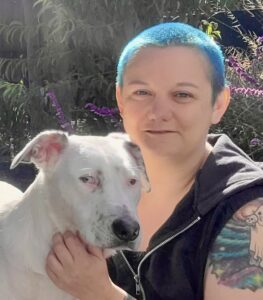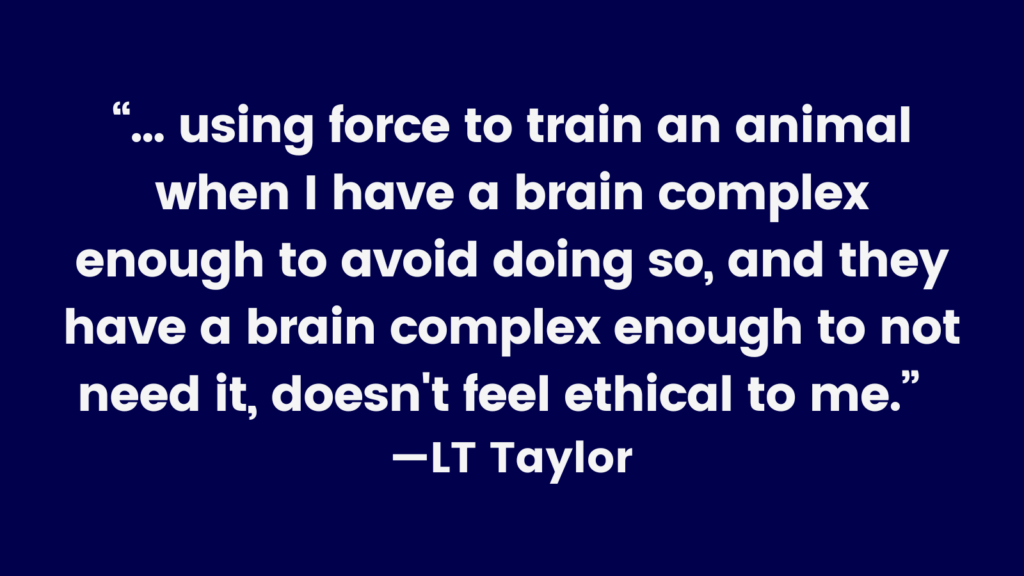Barks Blog
Meet LT Taylor, Whose “Hyperfixation” on Dogs Led to a Career in Animal Training

Tell us a little bit about yourself. How did you first get into animal behavior and training, and what you are doing now?
My mother is a dog breeder, so our house always had several dogs growing up, from Jack Russell terriers to Old English mastiffs. I became interested in behavior and training as a teenager, but then veered toward humane education and spent several years working at the San Francisco SPCA after graduating college. I loved working in sheltering but wanted to be more involved with the operations of the shelter, so I moved on to intake and data analyst positions. I then decided that municipal sheltering was a better fit for me and have been in the Behavior and Training Division at San Francisco Animal Care and Control (SFACC) since 2018. I’m a junior in Jean Donaldson’s Academy for Dog Trainers and plan to obtain my Certificate in Training and Counseling (CTC) this year. I’m also assisting Shock Free San Francisco (SF-ShockFree.org) with an ordinance proposal to ban e-collars in San Francisco and would like to assist with future efforts to guarantee informed consent for dog training clientele. I have spent several years volunteering with Rural Area Veterinary Services (RAVS) and look forward to returning this year.
Tell us a little bit about your own pets.
I have three dogs and one cat. Our cat, Tippy Toe, had microopthalmia, and her eyes were removed at 8 weeks of age. She’s a spitfire who overstimulates easily, but also loves to cuddle on her terms and has made a great hobby of bullying the dogs. All three of our current dogs are between the ages of 2 and 4. Ectophylla is a 5-pound chihuahua who was extremely malnourished and sick when she entered the shelter at 5 weeks old. (I had intended on taking her on foster only for that first night, but you know how it goes.) We adopted Louie during the pandemic. She’s a chocolate American bully with an impressive overbite who never leaves my sight if she can help it. Lemmy (Lemonade) is our most recently adopted dog. He entered the shelter last February as a deaf and shut-down adolescent stray who was at risk of euthanasia due to both his health and behavior. I had a feeling he would do well in my home, and I couldn’t have been more right. He’s honed my training skills a great deal and is one of the most affectionate and humorous dogs I’ve ever met.
What do you consider your area of expertise?
Behavior and training with a focus on sheltering and dog reactivity.
Why did you become an animal behavior and training professional?
I’ve had a strong interest in—some may call it a hyperfixation on—dogs since I was very young. I was one of those kids who pored over my dog breed encyclopedia and was eager to learn as much as I could. I had initially gone to school to become a high school teacher, but couldn’t shake my desire to work with animals. I did just that almost right after graduating and never looked back. I’m especially passionate about working with shelter dogs because they’re so often misunderstood, and because stress and anxiety play a large role in their welfare while they’re under the care of a shelter. I, myself, have an anxiety disorder, so it isn’t difficult for me to empathize with the heightened emotions shelter dogs typically experience or the behaviors they may display as a result.
What species do you work with?
I primarily work with dogs and am the primary dog volunteer trainer at SFACC, but I also love working with cats and especially love fostering under-socialized and semi-feral kittens.
Are you a crossover trainer or have you always been a force-free trainer?
I would consider myself a crossover trainer, based solely on how I was taught to handle dogs growing up. By the time I began seriously pursuing a career in behavior and training, I was already well on my way to subscribing to LIMA and force-free methods.

What drives you to be a force-free professional, and why is it important to you?
I feel strongly that it’s our responsibility to do right by animals we deliberately domesticated. Dogs love us—we made them that way. To spend all that time manipulating their DNA and then turn around and mistreat them feels very Stockholm-syndrome-y and counterproductive. Further, using force to train an animal when I have a brain complex enough to avoid doing so, and they have a brain complex enough to not need it, doesn’t feel ethical to me. I’ve spent a great deal of time exploring and learning as much as I can about the training methods I don’t personally utilize, because I’m the type of person who will drive myself mad if I don’t form opinions based on all the information available to me (not just the information that satisfies my cognitive biases). While I understand why many individuals and trainers rely on force-based methods, I don’t believe doing so myself would be a benefit to me or the dogs I work with.
Who has most influenced your career and how?
I would have to say that one of my former supervisors at the San Francisco SPCA, Megan Moon, has been the most influential figure in my career to date. Megan is the type of supervisor who pours her heart and soul into her work and is as hyperfixated on animals and their quality of life as I am. She leads strongly with her heart, and successfully convinced me that such leadership was not only possible but necessary in our field. Megan is emotional intelligence at its finest and a force to be reckoned with. As far as nonhumans go, my late Aussie, Zebra, influenced my career greatly. She accompanied me to work at the San Francisco SPCA every day and taught hundreds of kids how to approach and train animals with a focus on curiosity, collaboration and gentle kindness. She was Canine Good Citizen–certified and an Animal Assisted Therapy dog. When Zebra was a puppy, I was still using some force-based training, and she was immensely patient with me as I learned to do better by her.
How has the PPG helped you to become a more complete trainer?
PPG has opened me up to knowledge in areas of this field I might otherwise never have come in contact with or explored further. I purchase more webinars than I have time or money for because y’all are constantly putting out such good stuff!
What are some of your favorite force-free techniques for commonly encountered client-pet problems?
I deeply enjoy working with reactive dogs because (like many other force-free approaches) the focus is on games and having fun with your dog, as well as reframing your relationship with them as team based. I’m currently familiarizing myself with Dr. Amy Cook’s Play Way and have been fascinated by the benefits of learning through play. This shouldn’t have surprised me considering how often we utilize play in early childhood education!
What is the reward you get out of a day’s work with people and their pets?
We have very limited resources at my shelter, so getting creative with management and behavior modification strategies is key, and it’s immensely rewarding when I can whip something up that doesn’t stretch us too thin but still gets the job done.
What is your favorite part of your job?
I love training volunteers to work with challenging shelter dogs, especially reactive dogs. It’s magical to see the dogs’ demeanor change as they learn that their choices can produce desirable consequences, and equally as rewarding when volunteers learn how to advocate for the space and welfare of the dog they’re handling.
What is the funniest or craziest situation you have been in with a pet and their owner?
One of the unfortunate things about working in a municipal shelter in a major metropolitan area is that I’m privy to hilarious, confounding and downright unbelievable situations animals have found themselves in on a near-weekly basis, but I can’t share them due to personal privacy standards. I’m regularly bursting at the seams to broadcast some of the more interesting things I’ve been exposed to. It also always cracks me up when a new volunteer with no prior dog experience can’t operate a poop bag.
What special work-related projects or activities are you currently involved in?
My biggest current project is assisting with Shock Free San Francisco. While I believe strongly that dog training regulation beyond banning certain tools is deeply overdue in my country, I can’t deny that banning e-collars is a sensible jumping-off point and, I hope, a spark that will light the match of effective overall regulation.
How have these special projects or activities helped your business, career or service offerings?
Pro e-collar folks like to say that shelter surrender and euthanasia will increase if e-collars are not freely available to the public. That would obviously be antithetical to the work I do at SFACC. One of the reasons I feel so strongly about regulation in the dog training industry is because I have seen dogs surrendered to the shelter after e-collar or other punishment-based training attempts failed. Most recently, a surrender form stated the dog had been trained using an e-collar over the past couple months, resulting in a first-time bite incident and a poignant note from the family that the dog “just hasn’t been the same since we started using it.”
What’s next for you?
Obtaining my CTC is my main focus at the moment. Once I’ve done that, I’d like to work privately with clients to address on-leash reactivity, while continuing to split my time at the shelter.
What advice would you give to a new animal behavior and training professional starting out?
First and foremost, learn to read dog body language like a pro. It will make everything else so much easier and will continually inform how you approach training. Second, learn to be as kind to people as you are to their dogs. We’re all generally trying our best.
LT Taylor is with the Pet Professional Guild’s Shelter and Rescue Division.
